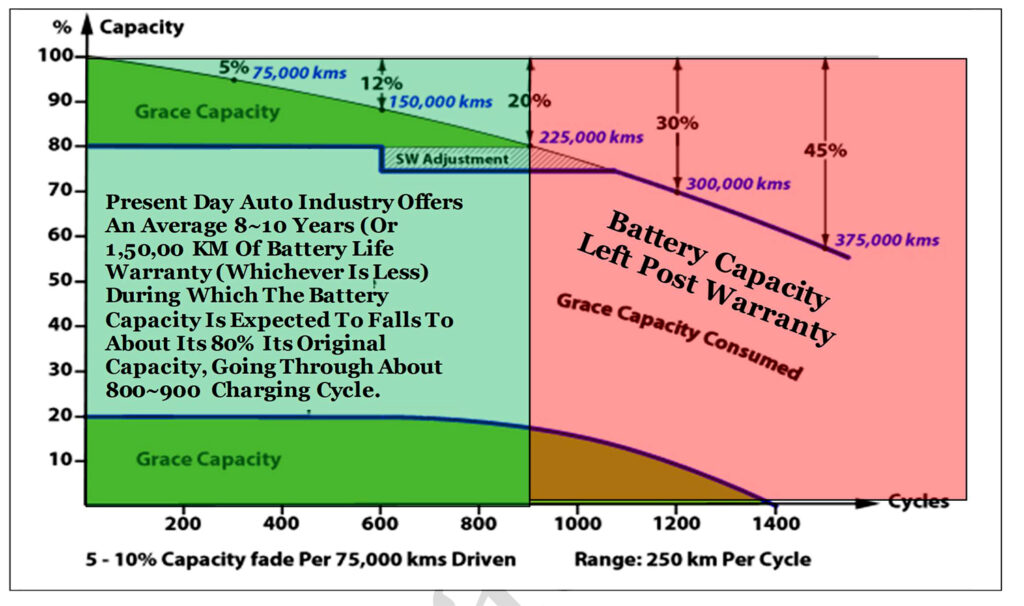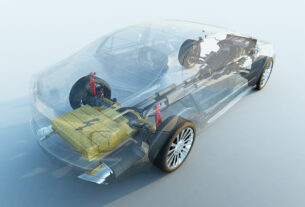By Prabhat Khare
Challenges & Future of EV Charging: Like everything else in nature, the EV-based mobility system is also not perfect and has its inherent drawbacks. The batteries (for its energy storage) are its weakest link but the good thing is that they are increasingly becoming better. The design life for an automotive quality lithium-ion battery ranges somewhere between 10 to 15 years. This differs from the warranty period which is generally 8~10 years for most applications which is unfortunately much less than the stipulated life of the vehicle, currently about 15 years (petrol) & 10 years (diesel) ICEVs in India. The EV OEMs, globally offer a battery warranty in terms of number of Years (which is 8~10 years) and/or KM run (which as of now is about 1,50,000 KM i.e. a mere 50 KM/ day of average running, considering a maximum of 10 years of battery life with an annual average running of 300 days every year. By this simple calculation, it is very clearly apparent that the present-day battery lives being offered certainly need to be enhanced. Fortunately, the batteries technologies are still evolving, hence we can expect the life span & performance of future EV batteries to improve. However, it is the other issue, not related to the EV technology, per se which is the biggest deterrent in acceptability of EVs and which needs to evolve at a much faster rate for increasing the general acceptability of EVs – and this is the EV charging infrastructure. If not done at the pace at which the EVs market is growing it could prove to be one of the biggest single factors in the mass acceptability of EVs. This is because the human mind is programmed to fall into this trap of unwanted “battery-based anxieties”, similar to what happens in the case of mobile phones . As such, these “anxieties” are not out of context yet they must be taken with a pinch of salt as the existing ICEVs can also run out of fuel if the tank is not filled at right time. However, the biggest thing in favor of already proven ICEVs is that the fuels which drive them (petrol or diesel) is portable in any quantity, so the ICEVs can be refilled anywhere, anytime, making them ready to move whereas EVs once drained of their battery stored energy, can only be charged at specified charging stations which must have power from backend supply. This single factor makes EVs vulnerable to get stranded in case they run out of their battery energy in the middle of road/ traffic/ highways.
[1]India Energy Storage Alliance (IESA) projects that the Indian EV market will be growing at a CAGR of 36% till 2026 while during the same period the EV battery market is projected to grow at a CAGR of 30% and both these growth rates are much higher than the growth of global EV market which is projected to grow only at a CAGR of 24.3% during the same period.
[1] LG conducted a survey on thousands of people and, although not a real illness or anxiety disorder, have dubbed the concept of “Low Battery Anxiety” to exemplify the behaviour of people who are changing their everyday lives – just to accommodate their dying battery. The survey found that nearly nine out of 10 people “felt panic” when their phone battery drops to 20% or lower.
EV Battery Charting Characteristics

Some Of These Perceived Battery-Related Anxieties Could Be:
- Range Anxiety For Driving Range: Although it purely depends upon the battery type, battery age, battery size as well as the driving habits & driving conditions, this has been one of the biggest worries of EV owners.
- Charging Time Anxiety For Recharge Time: This is the more serious drawback linked to EVs as a battery pack can take 3 to 12 hours for it complete charging. Even a “fast charge” from 0% to 80% capacity may also take about 30 min, unlike the ICEVs which can be moved as soon as the fuel is poured into their tank.
- Battery Life Anxiety: Though the batteries for EVs are designed for extended life, they may last 12 to 15 years in moderate climates / 8 to 12 years in severe climates (OEMs give a warranty of 8~10 years). Apart from climate, the battery life also depended upon the driving modes/ driving styles of EVs (frequent acceleration/ deceleration reduces the battery life) and once the batteries are unable to retain the energy, they need to be replaced at a very high cost.
- Charging Compatibility Anxiety For Charging Setup: As of now there is no standardization for the EV charging setup (i.e. for their connectors, voltage, rate, time) & varies based on the respective EV’s country of origin (USA/ Japan/ China/ EU) or the EV’s Manufacturer (GM/ Tesla/ VW/ BYD, etc.) unlike the two kinds of fuels for ICEVs – Petrol & Diesel). These incompatibilities become more complex when someone tries to locate an “EV-matched” charging station on highways/ expressways.
However, the crux of the issue is, that despite all these “New Technology Syndromes”, EVs are gaining popularity and their sales are growing year by year. It is expected from a study by Deloitte that by 2030 the EVs would be able to about 40% of the automotive market.

With everything in place for EVs, it is the charging infrastructure, which needs to be expanded at a much faster rate for sustaining the growth of the EV market. Knowing this, various government agencies/ policymakers are proposing many policies to standardize these EV charging setups to accommodate all kinds of chargers and as the mobility eco-system of EVs grows, many of these existing drawbacks will be taken care of and with improved battery performances, it would only be the issue charging system which may remain a challenge for a much longer time. This article tries to suggest some alternatives to address this issue.
Broader Picture Of EVs Charging Setup
There is a basic difference in the two forms of energies needed for ICEVs & EVs – one is an invisible form while another is invisible. Also, unlike the fuels of conventional ICEVs, which being in liquid/ gaseous form, can be conveniently handled in multiple ways – pipelines, tankers, containers of any size/ shape, etc. in varying quantities, the fuel of EVs (electricity) cannot be and needs specialized setup for its transmission, distribution & controls. Also, while the infrastructure for fossil fuels can be created & scaled up in a much lesser time (it can also function as a standalone setup), the EV charging infrastructure takes longer time to create and can never function as a standalone unit (it must necessarily remain connected to a power grid and always has a pre-decided capacity). Another major point that needs to be kept in mind is that while the ICEVs can be fuel-filled anywhere, the EVs can only be recharged at a designated place where electricity is available. And lastly, more importantly, even though electricity (being one of cleanest & safest form of energy) has become an integral part of our daily lives, and hence it is generically taken for granted. It is handled very casually but still as per the NCRB data of GoI, it caused a high level of deaths (in India there were 17,634 deaths due to electrocution alone in the year 2019), hence any EV charging setup can be left unmanned and would require a well-trained set of people to operate & maintain them.
Fortunately, the biggest advantage of EV charging is that they can be theoretically charged at any location and even while they are moving [@home (residential buildings), @work (small to large office buildings …), @destinations (public parking, hypermarkets …), @travelling (road, highways, city lanes….)].To make the EV charging a seamless process without any hassle, we will try to explore some of these possibilities in a bit more detail.
- EV Charging In Community Parking: Home is the most common place to charge EVs. It is cost-effective and convenient. While such arrangement would be manageable in the independent houses, the challenge would appear in the large gated communities. Since, the EVs in such facilities would generally be charged during the night, apart from planning to man them round the clock (both for operation & system safety point of view), the bigger challenge would be faced by DISCOMs, to cater for the increased energy demand during the night-time when this would be add-on load over & above the regular domestic loads. Issue of waterlogging & ventilation in the basement is other functional issues that must be taken care of for safe charging.
- EV Charging Stations: Workplace EV Stations are also becoming available at a growing number of companies, especially those committed to reducing the emission of greenhouse gases associated with their functioning. These setups also encourage employees to adopt EVs. Unlike the “EV Charging in Community Parking”, the “Workplace Charging” would be mainly done during the day, here also the DISCOMs need to create infrastructure to cater for the increased energy demand during the day-time over and above the regular demand.
- Commercial Building EV Charging Stations: Since, in commercial buildings such as supermarkets, shopping malls, restaurants, public car parks, and commercial facilities, the vehicle would be parked only for a short duration, the charging, if needed, would only be restricted to fast charging. However, the EV charging set up in such places would be needing some careful planning because of a two factors – first not all EVs may need charging while they are parked, hence designated areas need to be created (safeties included) only for those vehicles which are looking for charging. Second, DISCOMs need to make arrangements to meet the matched yet highly variable energy demand, the peak of which may come anytime during the day.
Other Charging Options To Popularise EVs
- Regular Charging Stations: In the future when EVs become the primary mode of transportation, it would be the right idea to create a chain of charging stations within the cities and along the highways/ expressways with the associated power supply infrastructures, similar to present-day petrol pumps. Primarily these charging setups would be fast charging installations where people can get their EVs quickly charged while moving around the city/ highways.
- Fast In-Transit EV Charging Stations: Fast in-transit charging stations are needed on expressways & highways where the charging time is an important consideration. In these EV charging stations, meeting the peak power demand would be most critical as in these stations, many EVs might be looking for fast charging & energy/ power demand would vary depending upon the battery condition of all those EVs plugged in for charging.
- Solar Powered Charging Stations (SPCSs): By converting all the parking sheds into solar-powered charging stations (SPCSs) which work as standalone units or can also be interconnected to create a grid system (they can also be connected to the electrical power grid)to work as EV charging setup. With the continual advancement in the efficiencies of the solar panels as well as the fall in price, these setups may catchup in times to come.
- Charging By Power Banks (Stationary/ Moveable): The approach is similar to SPCSs, except here the energy is proposed to get stored in large battery banks when not in use, like the concept of portable power banks, used for mobiles phones. There are two ways in which this setup could be used for charging the EVs – while the first option could be to install them at fixed locations within the city or along the highways, expressways as stand-alone power banks to act as regular charging stations (Sl. 1) while another option could be to make them portable by mounting them on vehicles with App-based GSP enables location tracking for the EV drivers to track them in the hour of need and approach them for help. In the future, they could be mounted on CAEVs so that they could quickly reach the distressed EVs. These emergency power packs could be charged either by green energies (solar/ wind etc.) and/or by conventional energy whenever they are not in use.
- Charging Through Street Light Poles: These are the add-ons, which are already available in the market and can be integrated with their counterpart smart street light poles. These add-ons offer a single-point charging setup suitable for charging one EV in case of an emergency. Such poles could be installed on various roads (market, parking, highways, etc.) with clear identification for charging the EV while it is parked or during an emergency, without affecting the main traffic. The Essen in Germany has already started putting up such smart street light poles. The European power utility EON has also developed similar smart poles.
- Battery Swapping: “Battery Swapping” as the name suggests, is a process in which discharged battery pack of an EV is interchanged (swapped) by the pre-charged battery pack, eliminating the charging time to reduce the “Range Anxiety”. Since these swapping stations would be set up to charge many battery packs over the stretched time, the charging can be done at a slower rate, needing a lower backend power setup with lower demands. In this system, battery being swappable, are not owned by the EV owner but by the owner of the “BaaS” (battery-as-a-service) model. The EV owner only pays for the energy cost with a buildup cost for the investment made by the BaaS operator. The biggest foreseeable challenge of this system would be to provide batteries of different shapes & sizes for EVs of different makes. The possible solution, though which as of now seems impractical, could be the standardization of unitary battery & combination format to build swappable battery banks for all 2W, 3W & 4W (irrespective of the brand) keeping safety in mind (any loose fitment of battery is always a safety risk for EVs). Despite its stated challenges, this is a promising option for single-brand EVs and also for promoting the EV revolution, and countries like China have already started implementing it.
- Wireless Charging
- From Bottom: The future parking & future smart roads can be made a network of embedded wireless charging setup (energy transmitter of Dynamic Wireless Charging Systems-DWCS) while the EVs can have the matched wireless energy receiver mounted at the bottom of their chassis. With this combination, EVs can be charged, while they are parked on the matched smart parking and/ or while traveling on matched smart roads by picking the power wirelessly. This will reduce the “Range Anxiety”, associated with the EVs, to a great extent. Further, this system, when expanded on all the road networks & all the parking, will allow EV designers to reduce the size of on-board battery capacity, allowing them to design a much lighter EV that can have much better EV performance. This would also help reduce the cost of battery replacement at its EOL. With time, this may finally evolve as “Charging on the Go”.
- From Top: This system can only be used while the vehicle is parked in a covered space as the wireless charging system (transmitter) is made part of the upper shade of the regular parking sheds while the matched transmitter is mounted on the roof of the EVs.
Any of the above charging systems could be fed by renewable energies, generated by multiple means such as by harnessing solar energy using the embedded solar panels on the road surface, installing solar panels along the road, harnessing the kinetic energy of vehicular movements using embedded piezoelectric energy harvesters below the road surface, installing wind turbines along the road (both regular wind turbines and/ or the wind turbines driven by the wind turbulence created by the vehicular movement on the road.
- Vehicle to Vehicle (V2V) Charging: If the airplanes can refuel each other in mid-air, then why not electric cars can charge each other while moving? The idea may look weird, as of today, but this is an idea out of the University of Florida which conceptualizes energy sharing by future EVs while driving in a peer-to-peer model. Apple has already filed a patent for a similar system way back in 2018 which may prove popular in the future when the number of EVs becomes predominantly large on the roads. Not only would this help in easing out any stuck EVs on road (in case it runs out of its energy in the middle of traffic), it would also be helpful for any distressed EV on a highway, seeking that little bit of extra energy to reach the nearest regular charging station. This V2V charging system could use multiple technologies such as wireless energy transfer between two EVs within a specific range, where body shells both the vehicles may become wither the transmitter or the receiver depending upon the situation as soon as their system gets locked & activated for this (while they are moving) or they could also possibly use flexible charging cables (while they are stationary), to share few pints of energy needed. Such universally acceptable features could be made an integral part of future EVs irrespective of makes & models so that the energy flow is seamless to the EV irrespective of its make, model, country of origin, etc. While the power transfer between EVs can be controlled and managed by a cloud-based control system for its safety & financial impact. This can begin the concept of “Charging on the Move”.
- Charging Using Pantographs: The use of pantographs utilizing electricity for road transportation is not new. Almost everyone has seen electric trams on roads, using some of these pantographs. With EV Buses & EV Trucks appearing for both city travel & long travels, this concept is getting revived again with, having two alternatives – one, with a pantograph mounted on the EVs roof of EV (On-board Bottom-up) while the second option the reverse way (Off-board Top-down) i.e. pantograph mounted on a structure.
- The “Onboard Bottom-up” pantographs on EVs can be used to charge EVs on their stops where they stop for a few minutes (on red lights at crossings in high-traffic areas or the end of the route) or also on their route of travel as is done in electrical railways (trams in olden days). This arrangement can be used for a quick charge while standing on red lights, in parking areas, on stoppages, and also while traveling on some routes which could have overheard power lines (remember old electric trams).
- However, the “Off-board Top-down” pantographs can only be used at specific locations and preferably be designed for fast charging as the EVs need to be parked below them.
Self-Charging EVs With Body Parts Made Of Solar Panels: While the first-ever solar-powered car “Sunmobile[1]” was made by William G. Cobb of General Motors in 1955, this was only a 15-inch model using 12 selenium PV cells & a 1.5 V battery using a small DC motor running at 2000 rpm which was housed in the front and the power to the rear wheel was transmitted using a simple chain & sprocket. This automobile was a miniature representation of the possibilities of solar energy in the future. Utilizing a similar concept & many of the technological breakthroughs which have happened over the last 65 years, few companies, like Sono Motors[2], are single-mindedly focusing on creating these self-charging solar EVs (their current models have about 250 solar cells, seamlessly integrated into car bodies, extending the travel range by about 120 km over the battery range). Thus creating an EV that can self-sustain over short distances. These new-age self-charging solar cars have small solar PV cells embedded in their body parts (roof, side panels, doors, front & rear hoods & even bumpers) which generate electricity during their exposure to light. However, due to aesthetic issues & design limitations of a car, it has been a real challenge till now to produce a viable & mass appealing car.
However, a point that must be remembered in context to the EV charging (like any other battery charging) is that though fast charging is convenient & fast, frequent usage of fast DC charging reduces the battery life and hence it must be used sparingly & cautiously. In the long run, it is slow charging, which must be perused for a longer life of batteries.

Epilogue
Despite the first revival of EVs in 1997, when GM had rolled out the EV1, the pace never picked up before it was buried unceremoniously by GM itself. Apart from factors mentioned in the documentary “Who Killed the Electric Car?”, unfortunately back then neither the battery technology was so advanced (EV1 was able to deliver only about 100 miles per charge) nor were the solid-state electronics (drives, controllers, & battery management systems) needed for EVs, and also it was a time when technology is of ICEVs were flooded by far too many innovations, eclipsing the growth of EVs. Then came another flood of hybrid vehicles combining the best of ICEV & EV technologies. The EVs were pushed back till, the rise of Telsa.
On the other hand, talking about electricity, after the fierce “War of Currents (AC vs. DC)” fought around the 1880s, Edison and Tesla DC were buried deep in Niagara Falls when in 1896, Buffalo was lit up by the AC from AC generators installed at Niagara Falls. While AC won the war, DC slowly vanished. However, with the rise of EVs in recent years DC is back in the market, a process that began with the rise of computers, LEDs & Solar PV cells. Yet, the rise of EVs is bringing both AC & DC power on a common platform where two current forms will be working in tandem, a sort of hybrid armistice. And none of this wouldn’t have been possible without the genius of both Edison & Tesla who had fought, tooth & nail for supremacy of their favored system. The rise of EVs would certainly give them a reason to rejoice in heaven and for shaking hands.





